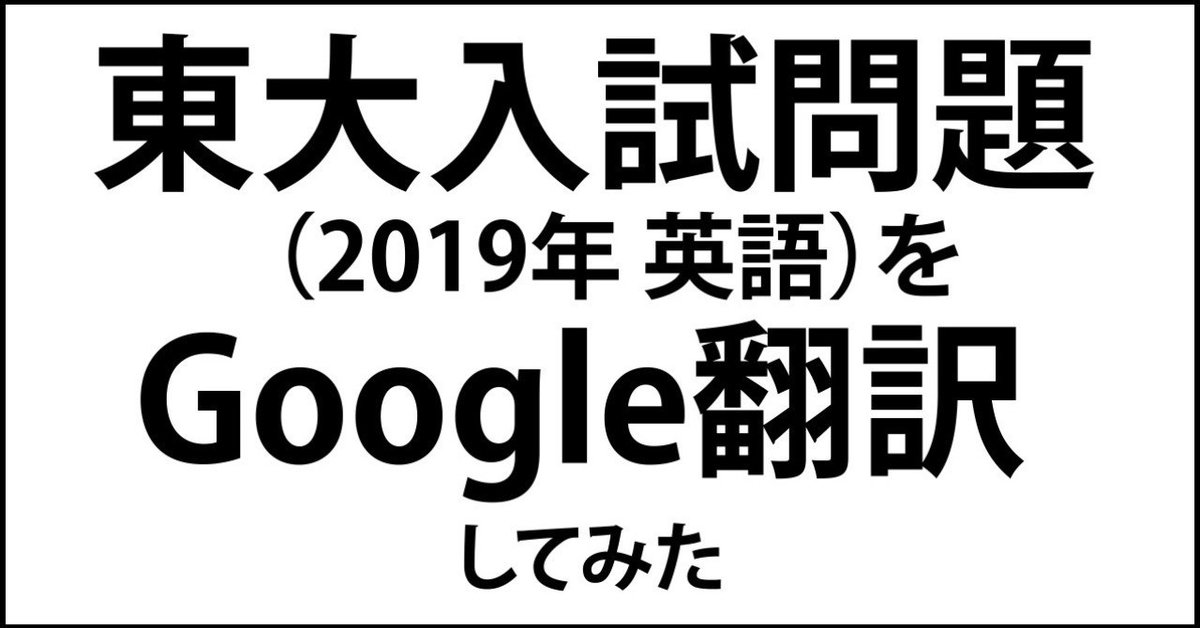
【早速ですが】東大入試問題(2019 英語)をGoogle翻訳してみました。
昨日(2月26日)実施された東京大学の英語(文類・理類共通)の入試問題を、早速ですがGoogle翻訳にかけてみました。東大を今後目指す方も目指さない方も、ご自身の翻訳力とAIの翻訳力を比べてみませんか?
今回は第1問(A)のみを翻訳します。この問題は、文章を読んで、その内容を日本語で要約せよ、という問題です。英文を最初に掲載し、その後Google翻訳の文を掲載します。Google翻訳には一切手を加えておりません。
In pre-industrial Europe, child labor was a widespread phenomenon and a significant part of the economic system. Until and during the nineteenth century, children beyond six years of age were required to contribute to society according to their abilities. From about the age of seven, they began a slow entry into the world of work, a world inhabited by both adults and children. The concepts of education, schooling, and protection against hazards were rare or entirely absent. In the early nineteenth century, children were also mostly viewed as the personal property of their parents, with few or no legal rights. Parents, mainly fathers, were given unlimited power and control over them and were allowed to treat them as they wished; physical punishment was almost universal and socially accepted.
This situation began to change as the nineteenth century progressed. Particularly in the half-century from 1870 to 1920, the rights of children in relation to parents, employers, and others expanded in the form of legal protection. Gradually, children began to be perceived as a separate category and not simply as the property of adults. The view that children have no more than economic value began to change and be replaced by the perception that they are a unique group that society has the responsibility to support and protect from the various dangers they face.
Another change in this period was the protection of children from parental abuse and neglect, which were subjected to intense scrutiny and challenged increasingly by government authorities. In 1889, both France and Great Britain passed laws against cruelty to children, including that caused by their parents. The nation became the defender of children’s rights. The child’s right to protection then led to the right to provision of various sorts, with the national government responsible for providing services. Health care, acceptable housing, and playgrounds — together with freedom from work and access to public schooling — emerged as elements of children’s rights.
産業化以前のヨーロッパでは、児童労働は広範な現象であり、経済システムの重要な部分を占めていました。 19世紀まで、そして19世紀の間に、6歳以上の子供たちは彼らの能力に従って社会に貢献することを要求されました。およそ7歳から、彼らは仕事の世界、大人と子供の両方が住んでいる世界へのゆっくりとした参入を始めました。教育、学校教育、および危険に対する保護の概念は、まれであるかまったく存在しませんでした。 19世紀初頭には、ほとんどの場合、法的権利を持たずに、子供たちは両親の私有財産と見なされていました。両親、主に父親は彼らに無制限の力と支配を与えられ、彼らが望むように彼らを扱うことを許された。体罰はほぼ普遍的で社会的に受け入れられていた。
この状況は、19世紀が進むにつれて変化し始めました。特に1870年から1920年までの半世紀には、親、雇用主、その他に対する子供の権利は、法的保護の形で拡大しました。次第に、子供たちは単なる大人の財産としてではなく、別のカテゴリーとして認識されるようになりました。子供たちは経済的価値以上のものではないという見方は変化し始め、社会は自分たちが直面するさまざまな危険から支援し保護する責任があるという独自の集団であるという認識に置き換えられています。
この時期のもう一つの変化は、親の虐待や怠慢から子供を守ることでした。そして、それらは激しい精査を受けて、政府当局によってますます挑戦されました。 1889年、フランスとイギリスの両国は、両親によるものも含めて、残虐行為に対する法律を子供たちに可決しました。国は子供の権利の擁護者となった。子供の保護の権利はそれから様々な種類の提供の権利をもたらしました、中央政府はサービスを提供する責任があります。仕事の自由と公立学校へのアクセスが可能なこととともに、ヘルスケア、許容できる住宅、遊び場が、子供の権利の要素として浮上してきました。
主に英語学習について、みなさんにお伝えしたいことを発信していきます。ご質問・ご意見はコメント欄へ何なりとどうぞ!
